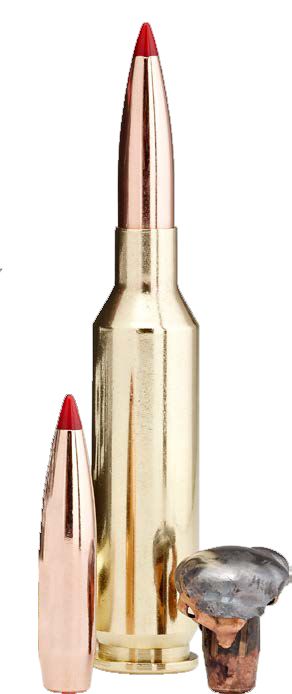It’s been a decade since the 6.5 Creedmoor was released. It is now an extremely popular round chambered by practically every major rifle manufacturer. While it steadily rose in popularity to become what it is today, its claim to fame also gave way to the development of a different cartridge – one well known in precision rifle matches and now finding a home in the mainstream shooting and hunting markets: the 6mm Creedmoor.
The creation of the 6mm Creedmoor was the result of an article on wildcat cartridges that John Snow wrote for Outdoor Life shortly after the release of the 6.5 Creedmoor. He worked with George Gardner of GA Precision to build the rifle for the article. Hornady provided a reamer, custom reloading dies and brass cases. The article was eventually published in 2010. Since then, John has continued to use the rifle and cartridge on various hunts and shoots.
A few years after the building the rifle for the article, George took another look at the cartridge for its use in precision rifle matches. Hornady started producing cartridge cases for GA Precision to distribute and in only a few years it became the number one caliber in the PRS (Precision Rifle Series) and has remained at the top. Eventually, Hornady added the 6mm Creedmoor cartridge case to their catalog lineup and in the fall of 2016 loaded ammunition was offered with a 108 grain ELD Match bullet. A number of rifle manufacturers have started chambering the 6mm Creedmoor in a variety of rifles – both match and hunting styles – so in April of 2017 Hornady announced a brand new 103 grain ELD-X bullet and loaded ammunition for the 6mm Creedmoor in the Precision Hunter lineup.
Many of the same features that made the 6.5 Creedmoor successful are also true for the 6mm version. They both share an efficient case design that leaves room for long, heavy bullets to be seated out without robbing powder capacity, while still maintaining a C.O.L. (cartridge overall length) compatible with short action rifles and AR-10 magazines. The same cannot be said for similar cartridges based off the 308 Win case like the 260 Rem and 243 Win. While they can be loaded with heavy-for-caliber bullets, it generally requires a longer action or seating the bullets into the case farther than optimal.
Strict specifications of both the cartridge case design and the chamber dimensions provide the optimum handoff of the bullet into the rifling to minimize in-bore yaw. Add to that a case size that is appropriate for burning up a whole
charge of excellent performing powders in the 4350, 4831 and RL-17 burn rate to reduce accuracy degradation from excess powder and gasses (ejecta) around the bullet as it leaves the bore.
The standard barrel twist rate for the 6mm Creedmoor is 1:7.5” whereas the standard for the 243 Winchester is a 1:10” twist. The faster twist is imperative in stabilizing long heavy bullets like the 103gr ELD-X and 108gr ELD Match bullets and others in their class. While the 243 Winchester has proven itself a capable cartridge over the years for traditional hunting of small to medium size game, a custom fast-twist barrel and possibly a longer action are needed to utilize bullets over 100 grains.
While the 6mm Creedmoor is a proven winning round in the precision rifle match world, it is only beginning to gain popularity in the hunting woods and fields. One of the features that makes it popular in PRS style matches is also going to add to its popularity in the field – seeing your hits. Precision rifle match shooters have moved to 6mm’s like the Creedmoor, 6×47 Lapua, 6mm Dasher and the like because they’ve found them to be the best mix of high BC (ballistic coefficient) and low recoil where they can see their hits and make adjustments as needed. While the 6.5mm bullet options offer even higher BC’s with bullets in the 130 to 147 grain range, the 105 to 110gr 6mm’s save enough recoil to make spotting hits that much easier, yet still have respectfully high BC’s. The Hornady 108gr ELD Match bullet has a G1 BC of .536 and the 103gr ELD-X is .512. With muzzle velocities of 2,960 fps and 3,050 fps respectively, they are flat-shooting, wind bucking, low-recoiling and accurate cartridges.
Hunters will find the new 103 grain ELD-X bullet quite useful on small and medium-size game. The low-end velocity threshold for expansion on ELD-X bullets is 1,600 fps, which at a muzzle velocity of 3,050 fps gets you to 900 yards at sea level, or out to nearly 1,100 yards at 5,000 feet elevation. To add to that, the ELD-X bullet is designed to still provide controlled expansion (without blowing apart) at traditional closer-range shots. Pronghorn and deer hunters have a great new option and predator hunters with “educated” coyotes that are reluctant to come in to calls now have a great 6mm option with low drag bullets for reaching out to them.
The 108 grain ELD Match bullet has a profile similar to the 103 grain ELD-X, but since it is not designed for controlled expansion, it has a much thinner jacket which means there is more room for lead, thus an increased weight. In its first year of being introduced, it is already proving successful in PRS series matches.
The future is bright for the new 6mm cartridge. With proven success at winning precision rifle competitions, the 6mm Creedmoor is sure to become a hit in the hunting world as well.
Editor’s Note:
We’d like to thank Gunwerks for allowing us to re-publish this piece that originally appeared in their Long Range blog.


